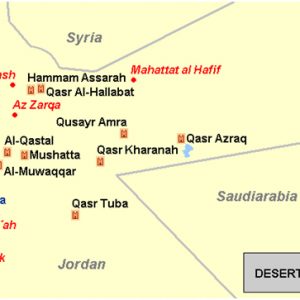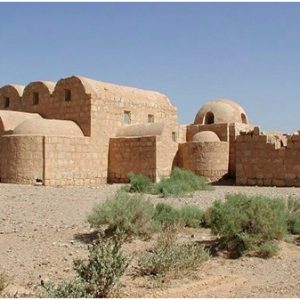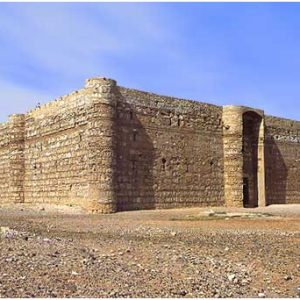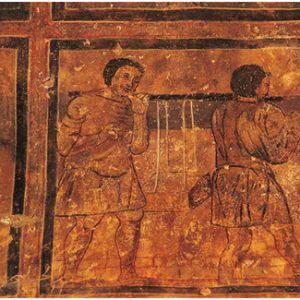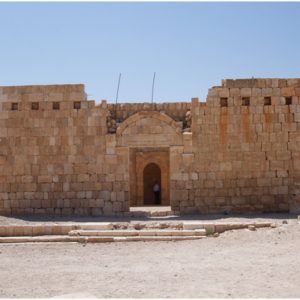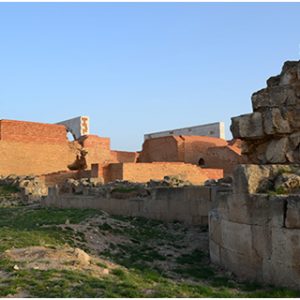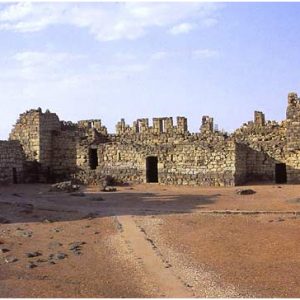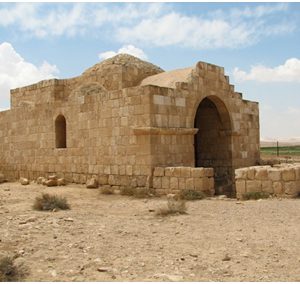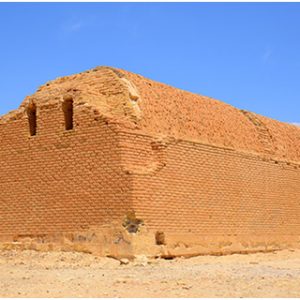The Desert Castles
Scattered throughout the black basalt desert, east of Amman, the Desert Castles stand as a testament to the flourishing beginnings of Islamic-Arab civilization.
These seemingly isolated pavilions, caravan stations, secluded baths, and hunting lodges, were at one time integrated agricultural or trading complexes, built mostly under the Umayyads (661-750 AD), when Muslim Arabs had succeeded in transforming the fringes of the desert into well-watered settlements.
Aside from being widely considered as the most spectacular and original monuments of early Islamic art, these complexes also served practical purposes: namely, as residences, caravanserais, and baths.
The Umayyad Desert Castles were initially desert retreats (Badiyas) for Umayyad princes who being of nomadic origins, grew weary of city life with all its rigors and congested atmosphere. Those castles allowed them to return to the desert, where their nomadic instincts could be best expressed, and where they could pursue their pastimes away from watchful eyes of the pious minded.
This theory, however, was challenged by the French scholar, Jean Sauvaget who argued they were indeed centers for agricultural exploitation, as these buildings were located on extensive and elaborately irrigated farmlands, which were often accompanied by various hydraulic structures.
This was reflected by the Umayyad policy to expand the agricultural zone into marginal areas.
Yet another and more recent explanation for the reason of these buildings is what might be called the “Architecture of Diplomacy”. That is, maintaining close contacts with the tribes of the region who were vehement supporters of the Umayyads.
It is also possible that some of these structures, like Qusayr Amra or Kharaneh served as resting places for high government officials on their way to Hejaz.
Al-Muwaqqar. Hammam Assarah. Qasr Kharaneh. Al-Qastal. Qasr Al-Mushatta. Qasr Tuba. Azraq Fort. Qasr Al-Hallabat. Qusayr Amra
Al-Muaqqae – Al-Muwaqqar
Virtually nothing remains of this qasr (palace) which once stood on an elevated mound surveying the desert and the cultivated lands to the west.
The qasr and the huge reservoir to the southeast are associated with the Caliph Yazid II (719-723 AD).
Numerous capitals decorated with acanthus leaves and Arabic inscriptions, as well as a water gauge to measure the depth of water in the reservoir, were recovered from the site.
Hammam Assarah
Situated 2 km to the west of Qasr Al-Hallabat, the plan of Hammam Assarah (Assarah Bath Complex) is strikingly similar to Qusayr Amra, though its masonry has a better finishing and its courses are more tightly joined. Its plan, like Amra, consists of 3 principal elements: The Audience Hall, The Bath Complex, and The Hydraulic Structures.
Qasr Kharaneh
This imposing structure is situated about 65 km east of Amman and 18 km west of Qusayr Amra. Kharaneh is one of the best-preserved Umayyad monuments in the Jordanian steppe. It consists of 61 rooms arranged into 2 levels surrounded by a porticoes central courtyard.
Al-Qastal
Al-Qastal lies 25 km south of Amman, on the highway leading to Queen Alia International Airport. Unfortunately, the site has been built on, and a large portion of the main building, the qasr (palace), has been subsumed by a modern house.
The qasr forms a square measuring 67.80 m to the side with 3-quarter round towers at the corners, and 3 semi-round towers on each side except the east entranceway. To the north of the qasr is the mosque with a round tower resting on a square base. This tower, with its spiral staircase, is all that remains of a minaret, which may well be, the earliest surviving minaret in the Islamic world. Plans are underway to restore the qasr and the ancient water system.
Qasr Al-Mushatta
Some 10 km southeast of Al-Qastal and within the precincts of Queen Alia International Airport, lies Qasr Al-Mushatta, the most famous of all the Umayyad palaces.
The monument reveals a mixture of Romano-Byzantine, Sassanian and Coptic influences evident in its construction technique (combination of stone and baked brick), roofing system, and decoration. The most remarkable feature of Mushatta, however, is its elaborately carved stone facade which now graces the Pergamum Museum in Berlin.
Qasr Tuba
Tuba is located about 95 km southeast of Amman. Like Mushatta, it was built using a combination of limestone blocks and baked bricks. Its plan consists of an oblong enclosure measuring 140 m by 72 m, almost a double square.
The northwestern quadrant is nearly intact and several lengths of curtain-wall exist on the western side. The rest of the building, which was never completed, is not preserved.
Azraq Fort
The copious springs in the oasis of Azraq made it an attractive place for settlement since the Lower Paleolithic Period.
In the Roman period, the site was a crucial spot because of its location near the northern tip of Wadi Al-Sirhan, the natural migration route between southern Syria and the interior of the Arabian Peninsula.
A chain of fortresses defended the entrance to the Oasis; Aseikim, 15 km northeast of Azraq and Uwainid, another 15 km to the southwest, close to the Shaumari Nature Reserve. The present fort at Azraq, built entirely from local basalt stones, was occupied from the time of the Tetrarchy (300 AD), as an inscription of Diocletian and Maximian suggests.
Another Latin inscription indicates that Azraq may have been called Dasianis or Basianis (The Basic) in Roman times. An Arabic inscription above the main entrance indicates a major rebuilding program in 1237 AD. During the Umayyad period, it was the place of retreat for Al-Walid II. An interesting feature of Azraq South (Azraq Al-Shishan) is a large hexagonal reservoir built of dressed basalt stones and strengthened by rounded and/or triangular buttresses, placed against the outer and inner faces of the enclosing walls. These features bring to mind the large enclosures at Qasr Al-Hir East and Qasr Al-Hir West in Syria, which date to the Umayyad period. Azraq fort was also the headquarters of Lawrence of Arabia during the Arab Revolt.
Qasr Al-Hallabat
Qasr Al-Hallabat lies 25 km northeast of Zarqa and 55 km northwest of Azraq Fort. The site comprises a conglomerate of separate and widely spaced units.
These include a qasr (palace), a mosque, a huge reservoir, 8 cisterns, an irregularly shaped agricultural enclosure with an elaborate system of sluices, and a cluster of poorly built houses.
The bath complex of Hammam Assarah, is situated 2 km to the east of the qasr. Originally Roman, this castle was rebuilt during the Umayyad period when it was elaborately decorated in mosaics, carved stucco, and fresco paintings, transforming the castle into a palatial residence. There are about 150 inscriptions within the castle, mostly in Greek. The vast majority of these inscribed stones belong to an edict issued by the Byzantine Emperor Anastasius (491-518 AD).
The Umayyad rebuilding program was accompanied by a remarkable development of the site: the addition of an extra-mural mosque with its beautiful cusped arches; the agricultural enclosure with an elaborate irrigation system; and the bath complex of Hammam Assarah.
Qusayr Amra
Situated 85 km to the east of Amman, is the little palace (Qusayr) of Amra, noted for its extensive fresco paintings covering all the interior surfaces constituting a unique artistic achievement in the Umayyad Period.
The site is since 1985 UNESCO’s World Heritage.
The paintings show themes such as hunting, dancing, and musicians, bathing scenes, cupids, and personifications of history, philosophy and poetry.

